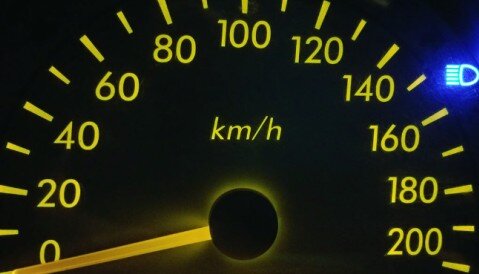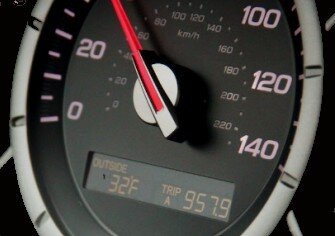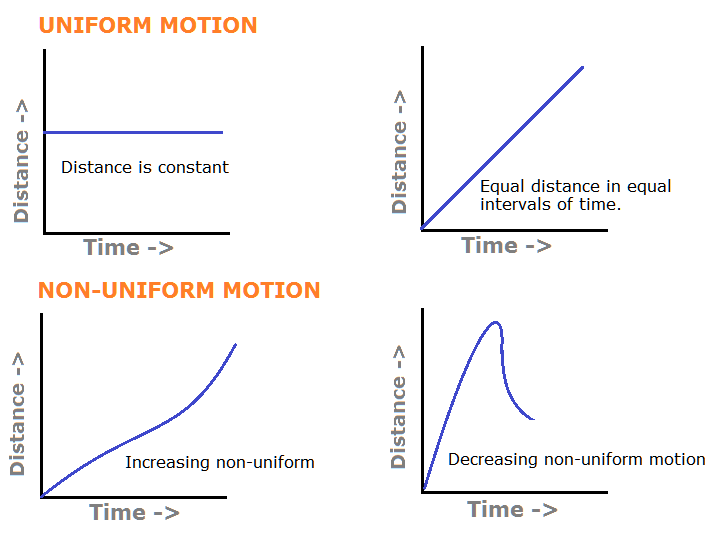Motion And Time Class 7 NCERT Science Book Notes

What is motion?
An object is considered to be in motion when its location in respect to its immediate surroundings changes over time.
Rest: When an object is said to be in rest, its location or position in respect to its immediate surroundings does not change over time.
Relative Motion: All motion is relative (referenced).

Two persons, sitting next to each other in a moving train, are at rest with respect to each other. While they both are in motion with respect to lady standing outside on the platform.
Types Of Motion


The oscillatory motion refers to the motion in which the object moves back and forth repeatedly. While periodic motion refers to the motion in which the objects repeats a path after a regular interval of time. All oscillatory motions are periodic but all periodic motions are not oscillatory.
A motion can be periodic and not oscillatory:
Clocks and watches which are used for measuring time are based on the principle of periodic motion. Uniform circular motion is periodic but not oscillatory. Motion of planets around the sun is another periodic motion example, that is not oscillatory.
The pendulum clock used for measuring time is based on the periodic motion of a pendulum.
Examples of Oscillatory Motion:
Pendulum Clock, Swing, Flapping of Wings.
The simple pendulum (An example of Oscillatory Motion):
A metal ball attached to a fixed thread at one end.
When Pendulum is at rest, it is in equilibrium position.
One complete To and Fro motion is called one oscillation of the pendulum. One oscillation is said to be completed when pendulum reach at the same position from where it started (initial position). The time taken to complete one oscillation is called time period of the pendulum.
To complete 20 oscillations, a simple pendulum needs 32 seconds. When did the pendulum start swinging?
Ans:
Time taken to complete 20 oscillations = 32 s
Time period of the pendulum = No of oscillations/Total Time taken = 32/20 s = 1.6s
Uniform and Non-Uniform Motion
When moving in a straight line with uniform motion, the object travels the same distance in the same amount of time. As demonstrated below in table, a bike, for instance, travels the same distance during the same period of time.

Bike travels the first 10 km in the first 10 minutes, the second 10 km in the second 10 minutes, the third 10 km in the third 10 minutes, and so on.
Therefore, we may state that an object moving at a constant speed in a straight line is said to be in uniform motion.
Non-uniform motion, on the other hand, occurs when an object travels a different distance in an identical amount of time along a straight line. Let’s explain using the preceding example, where a bike travels 10 km in the first 10 minutes, 15 km in the next 10 minutes, and so on. This indicates that the distance the bike covers in the same 10 minute interval varies. The motion is not constant.
Therefore, we can state that non-uniform motion occurs when the speed of an object moving in a straight line changes with time.
Time And SPEED (FAST OR SLOW)
Distance covered by an object in a unit time.
Speed = distance per unit time
Speed = Total Distance Covered/ Total Time Taken
Comparing Speed of two objects
Slow objects cover less distance in the same amount of time while fast ones cover a greater distance in that same amount of time.
Black car speed = 5/3 (m/s)
White car speed = 4/5 (m/s)
Let’s compare both fractions 5/3 and 5/5
Equivalent fraction of 5/3 = (5/3) x (5/5) = 25/15
Equivalent fraction of 4/5 = (4/5) x (3/3) = 12/15
As we can see 25/15 > 12/15
So, black car is moving fast as covering more distance (25 m) in 15s, whereas white car is covering less distance 12 m in the same interval of time (15 s).
Calculate Speed
Total distance covered by Soma (d) = 200 km
Total time taken (t) = 2 hours
Speed = total distance / total time
= 200 km / 2 hour
= 100 km/hour
So, Soma travels at speed 100 km/hour.
Instruments to measure Speed


International System of Units (SI Unit)
What is SI Unit (SI System)?
Universally recognised and utilised units of measurement are known as SI units. Having measurements in a single set of unit systems makes them easier to grasp for everyone.
What is base SI Unit or Standard Units of measurement?
The 7 basis quantities presumed to be mutually independent are given standard units of measurement known as the SI base units by the International System of Units (SI). They are notable as being the fundamental set from which all other SI units can be derived. The table below lists the seven SI base units:

Graph
A graph is a visual representation of data. Different graphs, such as bar graphs, pie charts, and line graphs, are used depending on the information and purpose.
Motion is depicted by a distance-time graph
The type of motion of an item, such as uniform or uniform motion, is shown via distance-time graphs.
Typically, we use a linear or straight line graph to represent an object’s motion. We choose a time axis (to display an independent variable) and a distance axis (to show dependent variable). A straight line that is inclined to the time axis represents the motion of an object travelling at a constant pace on a distance-time graph.
Typically, we use a linear or straight line graph to represent an object’s motion. We choose a time axis (to display an independent variable) and a distance axis (to show dependent variable). A straight line that is inclined to the time axis represents the motion of an object travelling at a constant pace on a distance-time graph.

